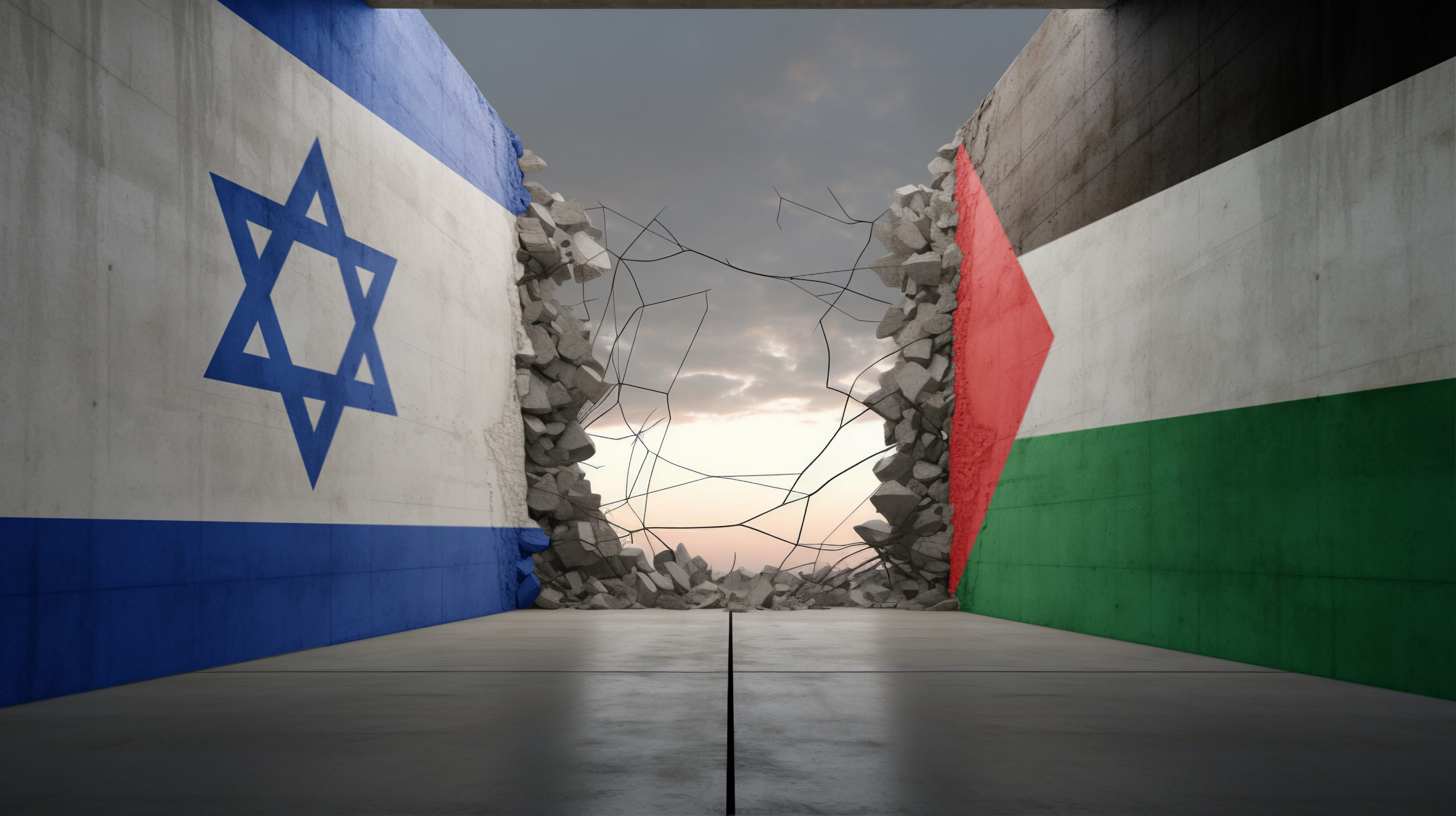The recent major escalation in the enduring conflict between Israel and Palestine, the most significant in decades, has led to an information surge on social media and news platforms. The large amount of disinformation and polarizing narratives complicate the task of making sense of the available information.
On October 7, the Palestinian militant group Hamas launched surprise attacks on Israeli territory, resulting in the deaths of several hundred soldiers and civilians, while over 200 civilians were taken hostage. In response, Israel declared war on Hamas and enforced a total blockade of the Gaza Strip. The blockade included cutting off the supply of water, electricity, fuel, food, and medicine. Additionally, Israel initiated air and ground attacks on Gaza.
According to data published by the Gaza administration, more than 18,000 people have been killed in Israeli attacks to date. In the occupied West Bank, over 270 Palestinians have been killed since October 7. The situation remains highly volatile, with both sides engaged in a conflict that has far-reaching consequences.
Navigating the Information Landscape
Escalation of conflict has prompted a deluge of information and misinformation across global media outlets, as well as social platforms. All SEE Check members reported a surge in disinformation. Among them, Raskrinkavanje.ba from Bosnia-Herzegovina, Raskrinkavanje.me from Montenegro, and Faktograf from Croatia have been at the forefront, conducting the highest number of fact-checking analyses: 31, 31, and 25, respectively, up until the end of November.
A notable trend in disinformation revolves around claims that certain events in the conflict are fabricated, including doubts about the authenticity of victims. Various network members debunked claims that CNN footage from the Israel-Gaza border was manipulated (1, 2, 3, 4). Additionally, a few articles circulated suggesting that the entire conflict was staged (1, 2, 3).
Several platforms have highlighted the use of artificial intelligence (AI) in spreading disinformation about the ongoing conflict. Faktoje debunked several images circulating on social media portraying children looking at explosions, determining that the images were generated by AI. They also came across a viral AI-generated photo falsely portraying the arrest of Israeli Prime Minister Benjamin Netanyahu.
Another fabrication involved claims that the soccer team Atletico Madrid displayed the Palestinian flag in their stadium (1, 2).
According to Feđa Kulenović, an information scientist based in Sarajevo, AI possesses significant potential for generating disinformation, and we might not fully grasp the extent of AI-generated content in the information we receive.
“It is impossible to discern what is AI-generated and what is not. Perhaps in some cases with audio and video material, we may be able to see certain things, especially when the prompt is poorly executed, but all of this is becoming very dangerous,” he said.
The misuse of video game footage is another concern, with excerpts from games falsely presented as real conflicts. Scenes from video games have been globally passed off as reality when reporting on the ongoing conflict. Raskrinkavanje.me, based in Montenegro, reported a local case where shots from a video game were falsely used to suggest that Hamas had taken down four Israeli helicopters.
Ivica Kristović, an editor at Zagreb-based Faktograf, highlighted a persistent challenge in reporting on war—constantly changing circumstances.
Kristović pointed out, “What is true one day may not hold the next.” To illustrate, he mentioned a case where Faktograf fact-checked a claim circulating online that Israeli forces had bombed an orthodox church in Gaza, concluding it was untrue. However, a few days later, the church was indeed bombarded.
The prevalence of disinformation motivated Raskrinkavanje.ba to publish a guide to aid readers with tips on verifying information during times of conflict.
Media Bias and Reporting Challenges
National Public Radio (NPR), an American non-profit media organization, has recently faced criticism from readers who accuse them of bias in their reporting on the conflict. Interestingly, the accusations don’t come from just one side; they’re being accused of bias both in favor of and against Israel. In a November article, NPR disclosed that 60% of the criticism labeled them as anti-Israeli, while around 24% accused them of having an anti-Palestinian bias. The remaining critiques didn’t specify a particular bias.
This isn’t a new experience for NPR. Criticism regarding their coverage of this conflict has been ongoing. From 2003 to 2014, in response to such concerns, they commissioned reports from an independent analyst to monitor their reporting on the conflict. Despite the reports concluding that NPR’s coverage didn’t exhibit signs of systematic bias, readers still feel there’s room for improvement. In a conflict that triggers emotionally charged reactions from most readers, achieving a balanced and objective perspective is an intricate challenge for journalists.

Accusations of media bias have been a significant aspect of the media coverage, with outlets like Al Jazeera and The New Humanitarian News agency pointing to a substantial pro-Israel bias in Western media reporting.
“Publishing unsubstantiated claims, telling only one side of the story, and painting Palestinians as nothing more than objects in Hamas’s hands are all unprofessional mistakes Western media makes while covering the conflict between Israel and Hamas, media experts and Arab journalists say” wrote Al Jazeera in an article at the end of October.
Similar accusations have circulated locally, with the Bosnian Mediacentar addressing the issue of pro-Israel bias in an article published in November.
“The geopolitical polarization of the global media is certainly visible in this conflict as well. The Western media, almost uncritically, showed a bias in favor of Israel and took pro-Israel positions through the creation of a narrative that implied the decontextualization of the conflict, often accompanied by misinformation and misleading content with the aim of generalizing and dehumanizing one side. Specifically, Palestinian.”
The language used to frame the conflict has also faced scrutiny, with concerns raised about double standards in referring to casualties. Some media outlets have been criticized for avoiding the term “terrorist” when discussing Hamas. Both AFP and BBC issued statements explaining their stance on not using the specific term.
“In line with its mission to report the facts without passing judgment, AFP does not describe movements, groups, or individuals as terrorists unless it is in direct quotes or with attribution,” stated the AFP.
In the view of the SEE Check members, the coverage of the conflict in the mainstream media in the region appears to be fairly balanced.
Rašid Krupalija, an editor at Sarajevo-based Raskrinkavanje, noted that the media outlets in Bosnia-Herzegovina mostly strive to inform objectively on the conflict. Marija Vučić, a journalist at Belgrade-based fact-checking platform Raskrikavanje, also said that she did not notice any particular bias toward either side.
“(That is) probably because this war is not of particular geopolitical interest to Serbia, unlike the war in Ukraine, in connection with which the media significantly manipulates. This does not mean that the reporting is professional, there are clickbait headlines and the like, but I did not notice much of any indicative bias.”
The lack of media content appears to reflect the political stance of the country’s leaders, who in this conflict have “opted for a kind of diplomatic invisibility,” in an attempt to maintain diplomatic ties with both Israel and the Arab League, as reported by Balkan Insight.
Darvin Murić, the Editor-in-Chief at Montenegrin Raskrinkavanje, said that the media generally report objectively, including reporting on civilian casualties.
Most mainstream media outlets in SEE do not have foreign correspondents who would be covering the issue. The media, thus, relies on foreign, mostly Western, agencies and media outlets to report on the conflict.
Viola Keta from Albanian Faktoje said that the media usually depend on their well-known international counterparts such as BBC, CNN, AP, Euronews and other comparable outlets. The situation is similar in other countries.
“When there is bias, it is transmitted,” said Ivica Kristović about the coverage of the conflict in Croatian media.
SEE Check reached out to multiple media experts, but many were reluctant to share their insights.
One expert stated, “None of my colleagues have direct experience related to the conflict in Gaza and its reflections in SEE. We did not conduct any studies, nor do I know that any other organization did.”
Regulation on social media
In a situation when there is a limited number of journalists on the ground, and communication networks are impaired, digital sources of information become especially important. Social media have become a way for many to share information, especially in the face of accusations of media bias.
However, social media are a fertile ground for disinformation, especially in a time of conflict. Some of the largest social media platforms faced accusations of bias, as well as deliberately silencing Palestinian voices. Social media users started talking of shadowbanning, or limiting the reach and visibility of their posts. Vox described the limitations on content about Palestine as “apparent but unclear”.
Information scientist Feđa Kulenović pointed out the challenges faced by social media companies in regulating content during conflicts. He told SEE Check that Meta and other social media companies simply do not have a regulation system that can handle special situations. Those systems, said Kulenović, are automated and react according to set rules. When it comes to conflict, those rules do not apply anymore and the automated system is doomed to fail. It is impossible, however, to employ a human-controlled system.
“Meta has a total of 60,000 employees. This small number of people is negligible compared to the number of users on Meta’s networks. It is impossible to manage this through human verification.”
Social media platform X (formerly Twitter) has a similar issue. Since it’s been taken over by its new owner Elon Musk, the platform has reportedly cut the size of the “trust and safety” department responsible for ensuring that the content posted to the network is accurate and not harmful, from 230 staff to roughly 20.
The issue is not new. In 2021, at the time of another escalation of conflict, there has been a record of suppression of pro-Palestinian posts. Meta admitted a human error in one instance, when all mentions of the al-Aqsa mosque had been deleted, since the term was incorrectly flagged as being connected to terrorist groups.
Even prior to that, there had been accusations of “systematic efforts to silence Palestinian content on social media.” 7amleh, the Arab Center for Social Media Development, published a paper in which they documented digital rights violations on Palestinian content.
Faced with the bias accusations, Meta hired independent assessors to look into the way they handled regulation in 2021 regarding the escalation of violence. The report highlighted apparent bias when it came to moderating Arabic posts, after which Meta has vowed to improve its content moderation in this region.

While the other major platforms have been accused of suppressing the Palestinian point of view, TikTok, on the other hand, has been accused of pushing a pro-Palestine stance – claims which the platform denied.
SEE Check reached out to Meta for comment. In their response, Meta directed us to their blog entry detailing their strategy for regulating the information about the conflict. The blog post stated:
“There is no truth to the suggestion that we are deliberately suppressing voice. However, content containing praise for Hamas, which is designated by Meta as a Dangerous Organization, or violent and graphic content, for example, is not allowed on our platforms. We can make errors and that is why we offer an appeals process for people to tell us when they think we have made the wrong decision, so we can look into it.”
Meta also addressed claims of limiting the reach of stories on Instagram, attributing it to a technical glitch.
“This bug affected accounts equally around the globe – not only people trying to post about what’s happening in Israel and Gaza – and it had nothing to do with the subject matter of the content. We fixed this bug as quickly as possible,” stated Meta.
Echo Chambers and Passionate Commentary
Fact-checking newsrooms in SEE have noticed an increase in passionate commentary on their debunks concerning the conflict.
Jordi Ilić, the social media specialist at Zagreb-based Faktograf, shared with SEE Check: “As with any conflict, we notice greater audience engagement in the form of comments, as well as social polarization in the form of misunderstanding towards a group that does not share the same views. Also, due to the escalation of the conflict, the number of negative comments, which are often of a discriminatory nature – in this case on religious or national grounds – is also increasing.”
Rašid Krupalija of Bosnian Raskrinkavanje told SEE Check that social media frequently become conduits for spreading misinformation, which was favored by the emotionally charged situation.
“A significant amount of misinformation was spread with the aim of expressing support for the population of Gaza, or in a smaller number of cases, support for Israel,” he commented.
Viola Keta from Albanian Faktoje echoed this statement, stating that, unlike the mainstream media, social media, various online portals and suspicious profiles spread fake videos and photos on the conflict in Gaza, which creates emotional reactions and inaccurate perceptions.
Raskrikavanje’s Vučić said she’s also noticed more bias on social media.
“Primarily, I’m thinking of right-wing, nationalist, anti-globalist channels on Telegram – although it is probably similar on other channels, but that’s where the audience interested in war topics primarily gathers, just as those who deal with health topics gather on Viber. They are, as far as I have noticed, primarily on the side of Palestine in this conflict.”

The conflict has proven to be highly divisive, with social media exacerbating the polarization by filtering content based on users’ existing opinions. Due to algorithms, users rarely come in contact with information that challenges their opinion. Feđa Kulenović highlighted the creation of echo chambers on social media, emphasizing the potential dangers.
“If one predominantly focuses on the Palestinian side, they’ll only encounter that perspective. They won’t be exposed to the other side’s viewpoint, and vice versa. For instance, in Germany, people might mainly see the views of Israelis, whether from officials or citizens, without understanding what is happening in Palestine,” he explained.
“This is where we run into the problem of one or multiple platforms controlling the narrative in a technocratic manner. Breaking out of this media bubble requires careful consideration and a deliberate effort to curb emotional reactions,” he told SEE Check.
Radoje Cerović, a psychologist and communication expert from Montenegro, emphasized that in times of war, bias tends to be more of a rule than an exception. Speaking to SEE Check, he stated that it is realistic to expect a certain level of influence from war propaganda on reporting. This underscores the complex challenge of maintaining objectivity in media coverage during a conflict.
“The conflict in Gaza has been going on for a long time and the blocs of opinions and positions are already very clearly defined. Each piece of information inevitably offers a simplified and out-of-context – temporal, political, social- whole. The truth in this case is inevitably much more complex. However, our system of mental shortcuts, known as heuristics, drives us to make swift and easy assessments of the situation, ideally confirming pre-existing opinions,” he explained.
As the Israel-Palestine conflict continues to unfold, navigating the complex and often biased information landscape becomes increasingly challenging, particularly given the dynamic nature of the issue and the limited resources available to journalists. Deciphering truth from disinformation and maintaining objectivity remains a challenge for reporters and audiences alike, especially in the face of pre-existing notions and emotional responses. In today’s era of digital media and algorithm-driven content, sifting through daily news is complex enough. The complexity is significantly magnified when trying to comprehend one of the world’s most long-standing conflicts.



